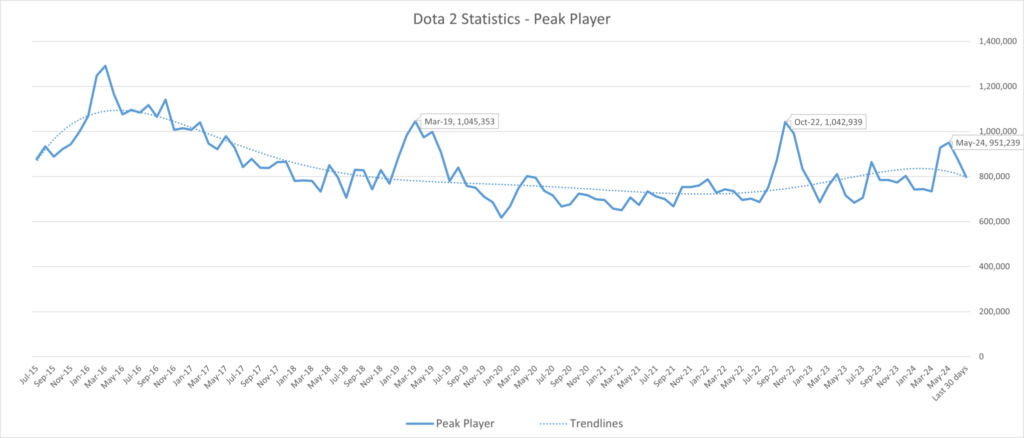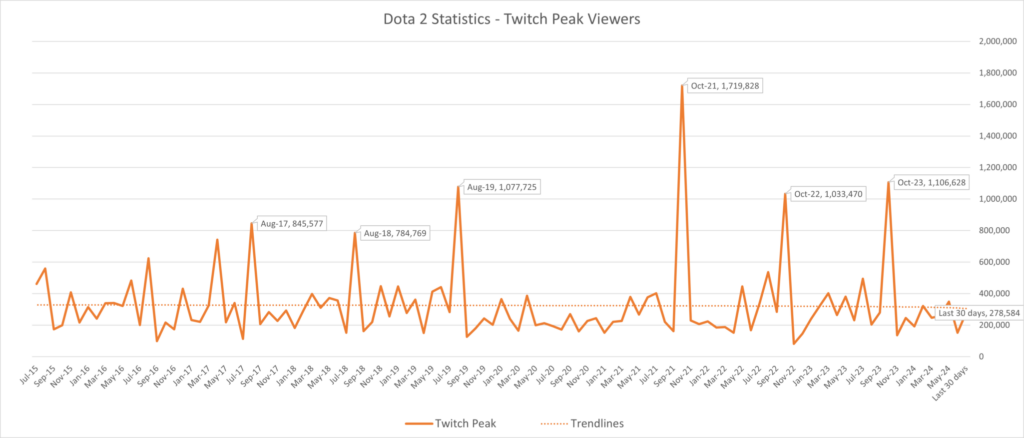We have several types of statistics to show you if Dota 2 is already dead or not. This impressive game has existed for a decade.
It's been 11 years since Dota 2's public release. Dota 2 is now often called a "dead game." But is this really true? In this article, we are going to analyze the current state of Dota 2 using data to see if it's truly dying.
Dead Dota 2 Player Statistics
First, let's look at the number of players. All data comes from SteamDB. The chart shows significant fluctuations in Dota 2's players over time.
For instance, the peak player count in March 2019 was 1,045,353. The most recent peak occurred in May 2024, coming with a major update, with a peak player number of 951,239.
The overall trend shows that peak player numbers increase significantly during major updates, big events, or tournaments. However, the long-term trend line indicates a decline in player numbers over the years.
Despite a decline compared to around 2016, player numbers have been stable and even show an upward trend over the past two years. The trend line here is plotted using a sixth-degree polynomial scale.
From this perspective, Dota 2 can't be called a "dying game" as it has stabilized for several years.
Twitch peak viewers
Dota 2's audience includes not only players but also many "spectator gamers" who only watch streams and tournaments without playing the game.
According to Twitch data, Dota 2's viewer numbers on the platform have remained stable for a long period. Significant spikes only happened during The International each year. For instance, in October 2021, when Team Spirit won TI as the underdog, the peak viewers reached 1,719,828. The trend line here is plotted using a logarithmic scale.
This data shows that Dota 2's viewer base remains stable throughout the year and can attract a large audience during major events. It also indicates that Dota 2 has long-term influence and is not dying from this perspective.
Dota 2 tournaments and prize pools
When it comes to Dota 2, we must mention its impressive prize pools. The International used to set new records for esports prize pools every year. However, in recent years, the ecosystem has changed.
Valve has canceled the Dota Pro Circuit (DPC) system, leaving only TI, after 2023. Meanwhile, the Riyadh Masters has emerged as an annual major event. Here are the prize pools for TI and Riyadh Masters over the years:
Year | The International | Riyadh Masters |
|---|---|---|
| 2024 | $1,600,000 | $5,000,000 |
| 2023 | $3,380,455 | $15,000,000 |
| 2022 | $18,930,775 | $4,000,000 |
| 2021 | $40,018,195 | N/A |
| 2019 | $34,330,068 | N/A |
| 2018 | $25,532,177 | N/A |
| 2017 | $24,787,916 | N/A |
| 2016 | $20,770,460 | N/A |
| 2015 | $18,429,613 | N/A |
| 2014 | $10,923,977 | N/A |
| 2013 | $2,874,380 | N/A |
| 2012 | $1,600,000 | N/A |
| 2011 | $1,600,000 | N/A |
We can see that TI's prize pool peaked in 2021 at $40,018,195. In recent years, the prize pool dropped sharply because Valve stopped releasing the battle pass. The Riyadh Masters' prize pool seems to match the previous year's TI. When TI's prize money decreased, so did Riyadh's.
After Valve canceled the DPC events, more tournament organizers entered Dota 2, like BLAST and CCT. PGL also returned to Dota 2, and the 2025 schedule is packed now.
Although canceling the DPC events took stable income from many tier-two teams, they now have new opportunities. Whether this change is good or bad, only time will tell. New event formats and more tournaments might bring fresh energy to Dota 2.
Dota 2 patches calendar
In recent years, Dota 2's update frequency has decreased. However, we still get a major update every year. For example, this year Valve added facets and innate abilities, making game strategies more diverse.
Year Dota 2 patches | 2024 7.36b, 7.36a, 7.36, 7.35d, 7.35c | 2023 7.35b, 7.35, 7.34e, 7.34d, 7.34c, 7.34b, 7.34, 7.33e, 7.33d, 7.33c, 7.32e | 2022 7.32d, 7.32c, 7.32, 7.31d, 7.31c, 7.31b, 7.31 | 2021 7.30e, 7.30d, 7.30c, 7.30b, 7.30 | 2020 7.28a, 7.28, 7.27d, 7.27c, 7.27b, 7.27a, 7.27, 7.26c, 7.26b, 7.26a, 7.26, 7.25c, 7.25b, 7.25a, 7.25, 7.24b, 7.24 | 2019 7.23f, 7.23e, 7.23d, 7.23c, 7.23b, 7.23a, 7.23, 7.22h, 7.22g, 7.22f, 7.22e, 7.22d, 7.22c, 7.22b, 7.22 | 2018 7.20e, 7.20d, 7.20c, 7.20b, 7.20, 7.19d, 7.19c, 7.19b, 7.19, 7.18, 7.17, 7.16, 7.15, 7.14, 7.13b, 7.13, 7.12, 7.11, 7.10, 7.09, 7.08 | 2017 7.07d, 7.07c, 7.07b, 7.07 | 2016 7.01, 7.00, 6.88f, 6.88e, 6.88d, 6.88c |
From the table, we can see that 2018-2020 were the years with the most frequent updates from Valve. Starting in 2021, the number of updates dropped sharply.
Based on the update frequency, it seems the game might be dying. However, recent major updates have had significant changes, indicating a large workload. But on the other hand, if the changes are substantial, shouldn't there be more small balance patches?
Is Dota 2 a dead game?
After finishing the whole article, do you think Dota 2 is dying or not? To be more precise, we should also look at the game's revenue, but Valve never makes it public. However, for a game that's been around for over a decade and still maintains hundreds of thousands of concurrent players, that's an impressive achievement.
Stay tuned to esports.gg and we will update more upcoming Dota 2 tournaments information!

